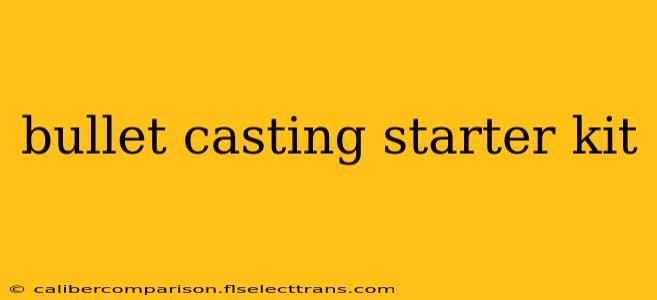Casting your own bullets offers significant advantages to reloaders: cost savings, consistent quality control, and the satisfaction of creating your own ammunition. However, diving into bullet casting can feel overwhelming. This guide breaks down the essential components of a bullet casting starter kit, ensuring a smooth and successful entry into this rewarding hobby.
Essential Components of Your Bullet Casting Starter Kit
Building a complete bullet casting starter kit requires careful consideration of several key components. Don't be tempted to skimp on quality; investing in reliable equipment upfront will pay dividends in the long run.
1. The Melting Pot: Your Core Component
The heart of your operation is the melting pot. This is where you'll melt your lead alloy. Several options exist, each with pros and cons:
-
Electric Melting Pots: These offer excellent temperature control and safety features, minimizing the risk of burns and accidental spills. They're generally easier to use, especially for beginners.
-
Propane Melting Pots: These are faster and can melt larger batches of lead. However, they require careful handling due to the open flame and potential fire hazards. Experience is recommended before using a propane pot.
-
DIY Pots (Not Recommended for Beginners): While some individuals create their own melting pots, this is generally not recommended for beginners due to safety concerns and the potential for inconsistent results.
2. Lead Alloy: The Foundation of Your Bullets
The type of lead alloy you use significantly impacts the quality and performance of your bullets. Pure lead is soft and can be difficult to cast accurately, leading to inconsistencies in bullet weight and shape. Therefore, using a pre-alloyed mix is recommended:
-
Linotype: This is a popular choice, offering a good balance of hardness and castability.
-
Wheel Weights: These are readily available and relatively inexpensive, but their composition can vary, affecting the final product. Always check the source and purity.
-
Pre-alloyed Ingots: Many reputable suppliers offer pre-alloyed ingots with consistent compositions, ensuring predictable results.
3. Bullet Molds: Shaping Your Ammunition
The bullet mold is what gives your projectiles their shape and weight. There's a wide variety of molds available, catering to different calibers and bullet designs. Choosing the right mold is critical:
-
Two-Cavity Molds: These produce two bullets at once, increasing efficiency.
-
Single-Cavity Molds: Simpler to use, especially for beginners.
-
Caliber and Bullet Design: Match your mold to your firearm's caliber and the desired bullet design (round nose, flat nose, hollow point, etc.).
4. Necessary Tools and Accessories
Beyond the core components, you'll need various tools and accessories for efficient and safe operation:
-
Ladle: For transferring molten lead from the pot to the mold.
-
Thermometer: Essential for maintaining the correct casting temperature.
-
Flux: Helps to remove impurities from the molten lead and improve the casting process.
-
Safety Gear: This is paramount! Always wear safety glasses, gloves, and appropriate clothing to protect yourself from burns and molten lead splashes.
Building Your Bullet Casting Starter Kit: A Step-by-Step Guide
-
Determine Your Needs: Identify the caliber(s) you'll be casting for and the type of bullet design you prefer.
-
Choose Your Melting Pot: Select an electric pot for ease of use or a propane pot for faster melting if you have experience.
-
Source Your Lead Alloy: Purchase a pre-alloyed lead ingot from a reputable supplier to ensure consistency.
-
Select Your Bullet Mold: Choose a mold that matches your caliber and preferred bullet design.
-
Gather Necessary Tools: Acquire a ladle, thermometer, flux, and essential safety gear.
Beyond the Basics: Expanding Your Capabilities
Once you've mastered the fundamentals, you can expand your bullet casting setup by adding:
-
Alloying Equipment: This allows you to create custom lead alloys tailored to your specific needs.
-
Bullet Lubrication System: Improves bullet feeding and accuracy in your firearm.
-
Sizing Die: Ensures your bullets are the correct diameter for your firearm.
Conclusion
Creating a bullet casting starter kit is a significant investment, but the rewards of producing your own high-quality ammunition are substantial. By carefully selecting each component and prioritizing safety, you can embark on a rewarding and cost-effective journey into the world of bullet casting. Remember always to consult and adhere to local and federal laws regarding ammunition manufacturing and possession.

